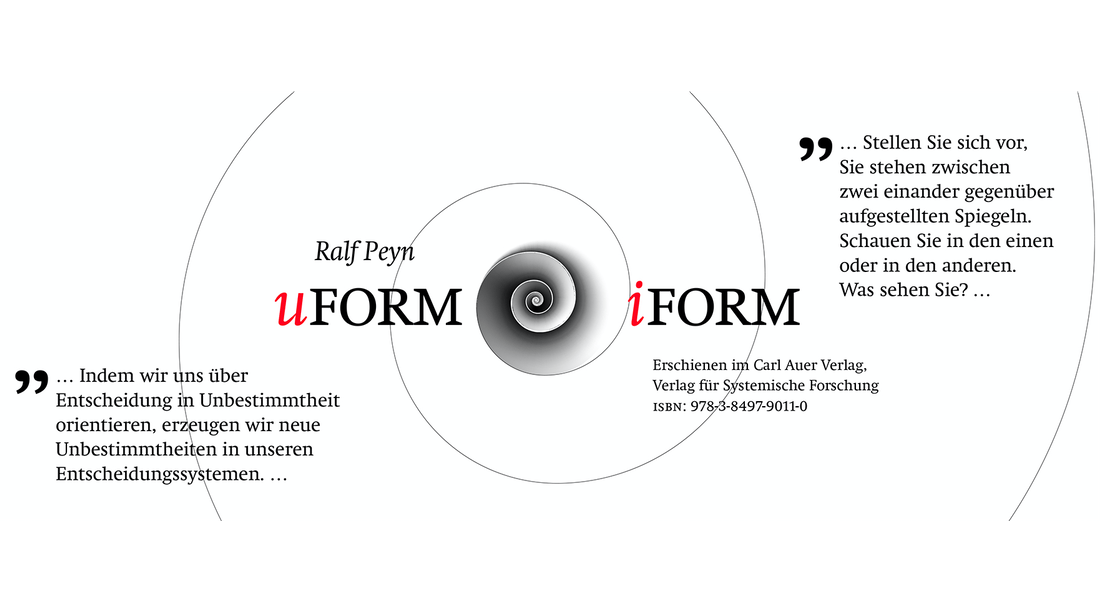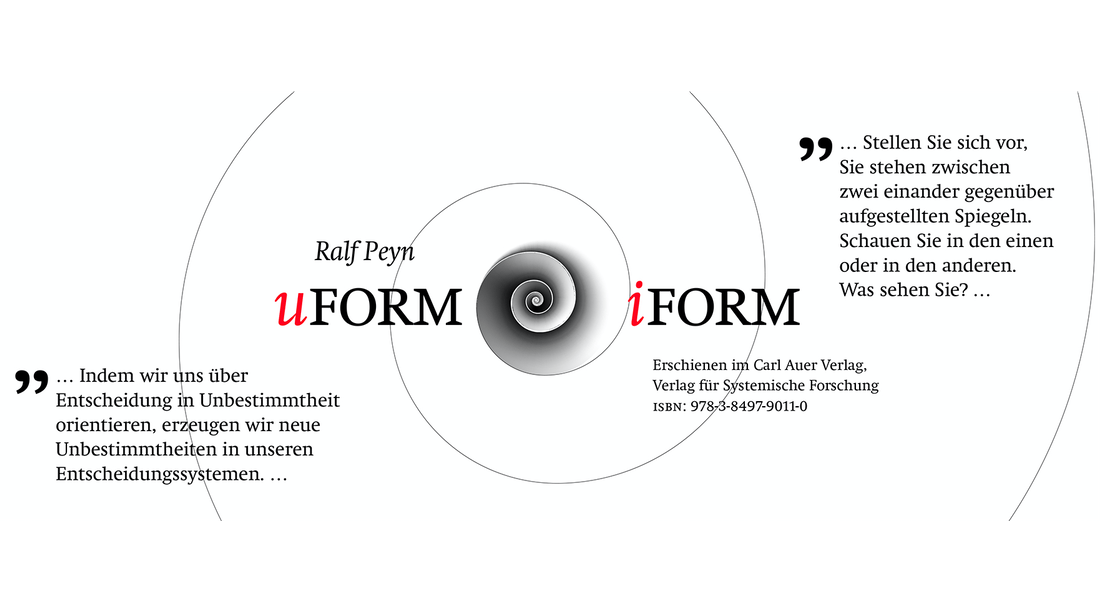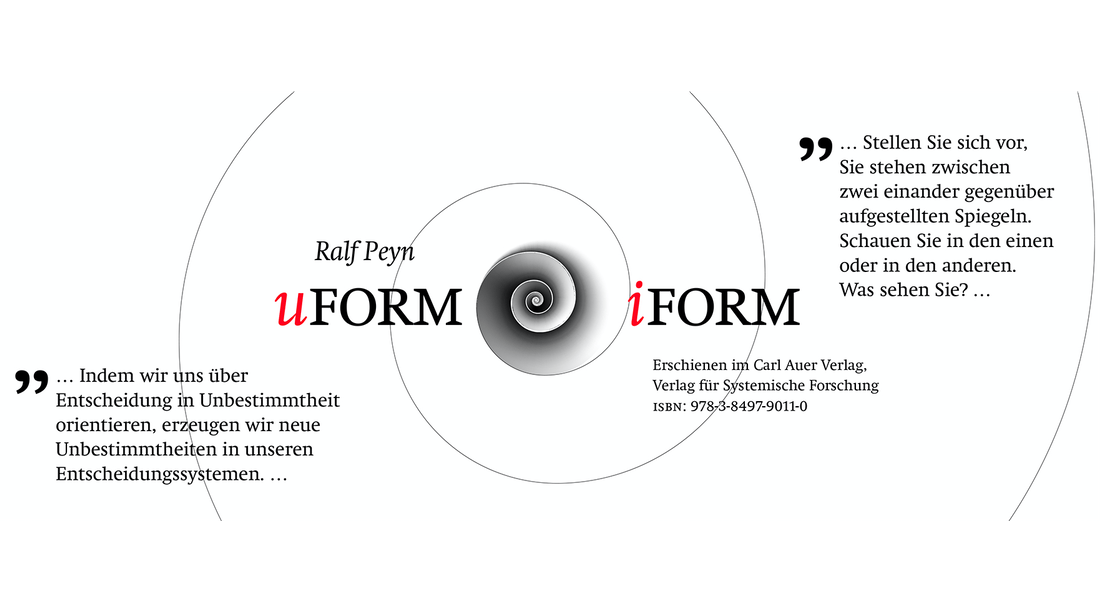Communication – Reorganization of Undetermined

With “Communication – Reorganization of Undetermined” (download here) new ways to analyse communication systems, structures, processes and … FORMs are opened up. All you need is the eBooklet, selftest or at least some videos and the willingness to dive in, explore and experience various communication/constructionFORMs. Find out how you can use these tools for a deeper, more complex, higher differentiated and broader dimensioned comprehending of your inner dialogues, personal realtionships, group dynamics, daily private and professional communications and also how you can utilize them for systemic analysis of social systems, communication systems and decision systems.
But first prepare yourself by reading my article on inFORMation (until the English version is online, use www.deepl.com) and understand that no one can inform anyone else. We cannot produce information into others. Realizing this is important on so many levels, that you will not be able to explore the full range of change in perspective possible with the new model, if you can not see the negative consequences of having a concept of information indiscriminately embedded in our concept of communication. Part of those consequences is a society that believes we can change the course of politics by “informing” the other. Part of those consequences are people arguing about “I have told you already”. Also part of them is a seriously disfunctional education system. And part of them is a society that cannot distinguish anymore between facts and bullshit.
All autopoietic systems inform themselves. They decide which event(s) select(s) (the) system(s) states. This is a decision made in retrospect. It is not an implemented control mechanism, neither in a single communication nor in complexes of communication. System specific information is a result of self-organization and should not be thought of as part of the system constituting elements, as also self-organization can not be part of the elements of autopoietic systems. Often even the system itself does not know/realize/is not aware of what event or complex of events has been used as information, because all complex autopoietic systems are depending on invisibilized processes – otherwise they could not perform the simplest tasks.
In the proposed reference for communication (triple selection of deeming, telling and understanding) all three FORMs, deeming, telling and understanding, have their own information cycles. And nobody can (exactly) prognosticate which or in what combination or how or whether anything out of this particular communication at all a/the social system will use as information. And we also can not say what the involved people will do. We just can’t tell. No psyche has any direct access to other psyches, and no psyche has direct access to a/the social system and communication.
What we can do is to analyse the FORMs/systems we observe. We can use the full range of this triple selection and all combinations thinkable to create new perspectives on/for our expectation structures and communication processes. We can create new observer viewpoints/platforms to generate and exchange new ideas on what we can see here right now.
Imagine this: Many people believe they know what other people deem (mean). Many also believe that they can precisely isolate the telling behaviour, and many think that they actually understand the content of what the other(s) mean(s). But that is not how evolution works. Complex organized life forms individuality to improve the chances of survival. And individualities need the complexity of deeming, telling and understanding and of combinations of deeming, telling and understanding to not break apart. Communication originates from and re-organizes complex FORMs, undecidabilities, double contingencies. What the system processes as deeming, as telling, as understanding is dependent on the system. The living system decides and proceeds. It might react on a telling that we could never have imagined as becoming seen as telling. It can understand in ways totally inaccessible to our prediction. It might decide to act on a meaning nobody involved in the communication would individually identify with. The communication system selects its (informative) communication, not its umwelt. Niklas Luhmann said: “Only communication can communicate”, you can’t. We can make ourselves as clear as possible, we can listen as attentive as possible, but we have no direct and predetermining access to communication itself. So the more complexity the models we work with to broaden our perspectives on/for communication can handle, the better for us. As long as we can respecify them, with advantage and success.
We can run these new observer view(point)s generated with “Reorganization of Undetermined” as emulations and then we can watch the system generated from this particular FORM evolving. Then we can compare them to real life situations, to us as interacting persons/people, to communication structures in ordinary daily situations, in therapy, in corporations and in social (sub)systems as a whole and we can ask: Is this the system we expected? Is this the world developement we wanted? What has to change? Then we see where in our FORMs changes can be made and re-run our emulation. This way we learn a lot about decision making systems by doing, about expectations and how they play their part in complicating/simplifying communication procedures, where we might change or improve. And we can learn a lot more about how to handle and survive the complexity of communication and social systems themselves.
In “Communication – Reorganization of Undetermined” Ralf presents various FORMs and combined FORMs for analysis. Just read the booklet carefully, watch out for every single (and simple) sign. I will give you now some help on how to read it, and you will see what an easy-going it really is:
- On page 4 see that Ralf uses M ! V as tokens for Deeming, Telling and Understanding. Have a look at the bottom of the page.
- Try and FORM the FORMs in yourself. Observe your inner dialogues, imagine some interactions with others you had. Try to find as many real life situations as possible:
What have your expectations been in this situation?
How did you communicate in that environment?
But even more try and find communications as referenced above in the wider view of a/the social system. - On page 5 you find the first simple FORMs and their binary codes.
- With the help of selftest you can run these FORMs and see how they evolve.
- In order to do this you just have to convert the binary code into decimal:
Look at the following FORM: 100000. 0 means no value, 1 means insert the value that belongs to its position.
If all positions would be set as 1, you would have: 32, 16, 8, 4, 2, 1.
So in 100000 only one position is set, the last one (counted from right to left).
This particular FORM as decimal number is 32.
If your FORM is: 010000, it would be? … 16
If it looks like: 100110, it would be? … 32, 0, 0, 4, 2, 0. It adds up to: 38. - Open selftest. Activate triple selective FORMs with “64c”. Set to random initialization with “10x”. Now type the decimal number of the FORM plus “n”.
In our first example you type “32n”. - The half arc above the FORMs on the left and the right side denotes an interchange inside the FORMs. Just compare the FORMs on the left side with those ones on the right and you will see.
- Gliders are FORMs that move through the system. Please read my article series on “How does System function/operate” in this blog.
- Compare the systems you create with each other. Follow the initialization and watch what happens.
- What could “drifting” mean in real life situations? Rhythmization? Narrow? Wide? Become creative, think. Depart from this mindset where you wish others to show you examples thus narrowing down your range of creativity and imagination.
- What monotone systems/FORMs do you know and in what respect are they relevant (for orientation, progress, success)?
- What are the main differences between SenseFORMs and other FORMs. When you look at the left- and the right-oriented systems, what has changed, what stayed the same?
- See what happens, if you change one value/FORM set active (1) to inactive (0) or the other way around.
- Try and imagine daily life situations and try to change them by changing communicationFORMs.
- On page 11 see that the arrow with the two ends denotes a relation/connection/resonance between the concerned FORMs above and below.
- Continuing on page 12 follow the relations/connections/resonances and you can generate meaning along the arrows.
Use the comment function of this blog to ask questions and to show your examples. Your ideas will help others to create more of their own and together we jam …



